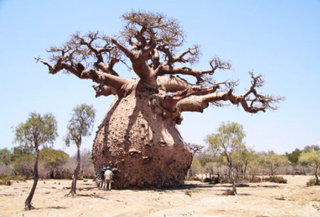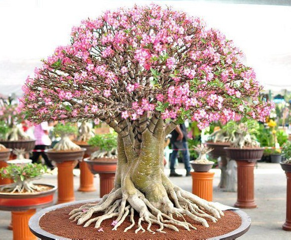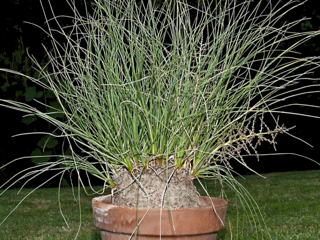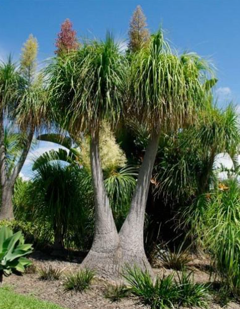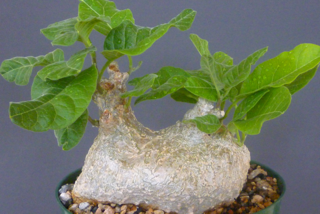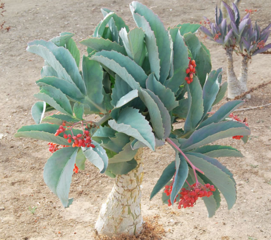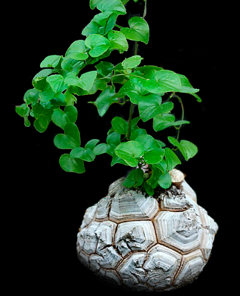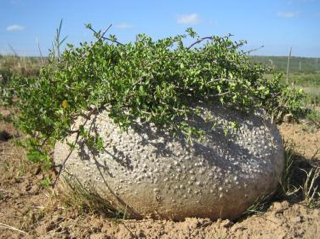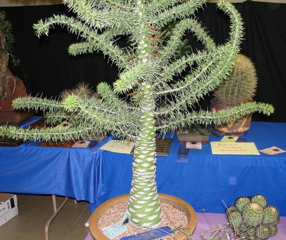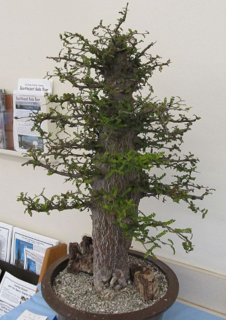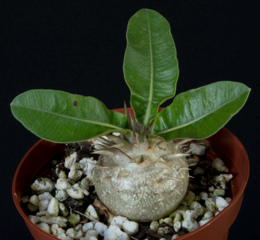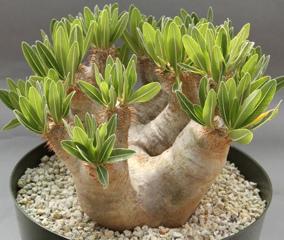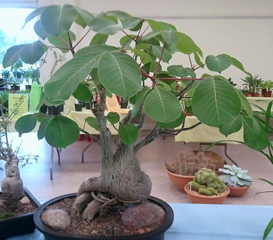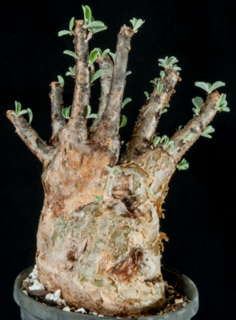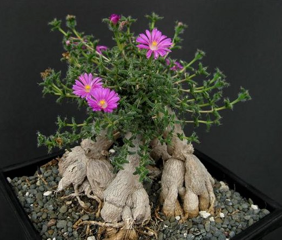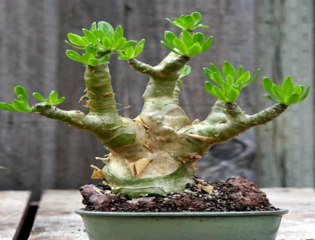Submitted by: Jim Tanner
Caudiciform plants, also known as ‘Fat Plants’, are a grouping of many totally unrelated plants all having a fat, short, swollen stem-trunk.
A fat, short, swollen stem is referred to by botanists as a caudex, while plants that display this kind of growth habit are called caudiciform plants. Caudiciform plants are almost exclusively desert dwellers that use their swollen stems for water storage between periods of drought. Cacti, especially the barrel type, have short, swollen stems, but are excluded because their stems have the major photosynthetic role. Caudiciform plants are found in many families, including the passion vine family, the grape family, the euphorbia family, the dogbane family and the baobab family.
In nature, these fat-stemmed plants can attain enormous size. Baobab trees (Adansonia sp.) of Africa and Madagascar have swollen trunks more than 50 feet in diameter with what often looks like a modest topknot of growth to support the enormous base. The ponytail palm (Beaucarnea recurvata = Nolina recurvata) of Mexico can have swollen bases 4 to 5 feet across.
Some of the most beautiful caudiciform plants are the Adeniums, known collectively as desert rose. In the wild, Adenium obesum, has swollen stems to 3 or 4 feet across. Most caudiciform plants, are propagated by cuttings.
Caudiciform plants adapt well to pot culture and are easy to grow. Caudiciform plants are frost-tender and even 28 degrees will kill most of them. Most of these plants grow during the hot summer months and are dormant during the winter, so they adapt well to moving indoors during the winter. Evergreen species will need a bright location during winter. Ideally, a cool greenhouse maintained at 45 to 50 degrees is perfect for overwintering most kinds.
To keep the size of the plant somewhat in check and lessen the possibility of overwatering, keep the pot size of caudiciform plants relatively small for the size of the plant. When repotting, use a clay pot and a good, well-drained potting soil designed for cacti.
LATIN LOOKUP – Loquerisne Latine (Do you speak Latin)?
The meanings of latin plant names on this page – from http://davesgarden.com/guides/botanary/
- Adansonia [ad-an-SOH-nee-uh]
Named for Michel Adanson, 18th century French surgeon, botanist and naturalist. - Adenium [a-DEE-nee-um]
Named for Aden, a small country south of Saudi Arabia, where the species is native. - Beaucarnea [bow-KAR-nee-uh]
Named for Jean-Baptiste Beaucarne, 19th century Belgian plant collectors. - brevicaule [brev-ee-KAW-lee, brev-ee-KAW-lay]
Short stem. - bulbosum [bul-BOH-sum]
Bulbous. - Calibanus [kal-IB-an-us]
Named for Caliban, the beast-like monster who was Prosperos’ slave in Shakespeare’s The Tempest. - Cibirhiza [sih-bee-RY-zuh]
From the Latin words cibi (food) and rhiza (root). - Cyphostemma [sy-foh-STEM-uh]
From the Greek kyphos (tumor, hump) and stemma (garland, crown). - decaryi [de-KAR-yee]
Named for Raymond Decary, 20th century plant collector. - densiflorum [den-see-FLOR-um]
Densely flowered. - digitata [dig-ee-TAH-tuh, dij-ee-TAH-tuh]
Finger. - Dioscorea [dy-oh-SKOR-ee-uh]
Named for Pedanios Dioscorides, first century Greek pharmacologist. - edulis [ED-yew-liss]
Edible. - elephantipes [ell-uh-fan-TY-peez]
Elephant foot (stem). - elephantopus [el-eh-fun-TOE-pus]
Elephant’s foot. - ellipticum [ee-LIP-tih-kum]
Elliptical, about twice as long as wide. - Fockea [FOK-ee-uh]
Named for Dr. Focke Albers, modern-day German professor and expert on the Asclepiadaceae family. - Fouquieria [foo-KWEER-ree-uh]
Named for Pierre Edouard Fouquier, 19th century French physician. - hookeri [HOOK-er-ee]
Named for Sir William Jackson Hooker, 19th century botany professor & director of the Royal Botanical Gardens at Kew; or his son Joseph Dalton Hooker, 19th century British botanist & plant collector. - juttae [JOO-tay-ee]
Named for Jutta Dinter, the wife of Professor Kurt Dinter, 20th century German botanist and collector in Africa. - Kleinia [KLINE-ee-uh]
Named for Dr. Jacob Theodor Klein, 18th century German zoologist. - lugardii [loo-GAR-dee-eye]
For 19th century plant collector Major E. J. Lugard. - neriifolia [ner-ee-eye-FOH-lee-uh]
Oleander-leaved (also spelled nerifolia). - obesum [oh-BEE-sum]
Fat. - Operculicarya [oh-per-koo-lee-KAIR-yuh]
From the Latin operculum (little lid) and Greek karyum (nut), referring to the lidded, nut-like seeds. - Pachypodium [pak-uh-PO-dee-um]
Thick foot. - paniculatus [pan-ick-yoo-LAY-tus, pan-ick-yoo-LAH-tus]
Referring to the flower clusters (panicles). - Pseudobombax [soo-doh-BOM-baks]
False Bombax (genus name from the Greek bombyx, silk; referring to the silken fibers). - purpusii [pur-PUSS-ee-eye]
Named for brothers Carl and Joseph Purpus, two early 20th century German plant collectors. - recurvata [rek-er-VAY-tuh]
Bent backwards. - saundersii [son-DER-see-eye]
Named for the botanist who discovered it in South Africa in the late 1800s. - Sesamothamnus [ses-uh-moth-AM-nus]
From the Greek thamnos (shrub) and the genus Sesamum; Shrubby Sesamum. - Trichodiadema [try-koh-dy-uh-DEE-ma]
From the Greek thirix (hair) and diadema (band around the head); referring to the crown of bristles on the leaf tips. - Tylecodon [ty-lee-KOD-on]
An anagram of Cotyledon (a closely-related genus).
